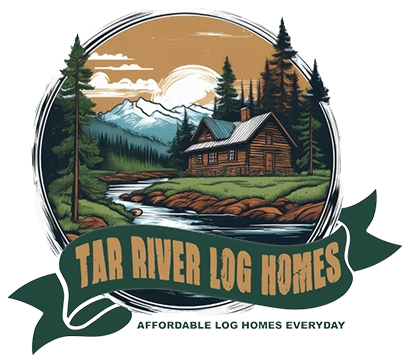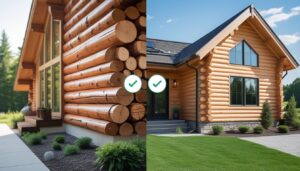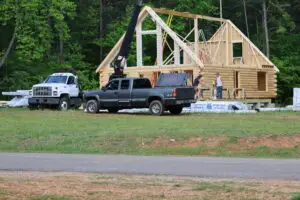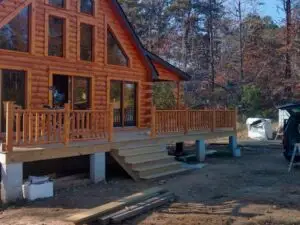Choosing between log cabin siding and full log walls depends on your budget and desired vibe. Log siding gives you that cozy log home look for less money and hassle. On the other hand, full log walls bring the real-deal log cabin experience. They also come with more insulation and old-school durability.
If you’re after an affordable way to capture that classic log home charm, siding’s a solid pick. But if you want a home that feels sturdy, full log walls might be worth the extra.
At Tar River Log Homes, we’re all about helping you find what works for your goals. Plus, we do it all without trying to upsell or put any pressure on you.
Let’s get into the details so you can plan your dream cabin with a bit more confidence. Use this guide to compare cost, care, comfort, and long-term value.
Understanding Log Cabin Siding
Log cabin siding lets you fake the log look without going all in on full logs. There’s a bunch of choices out there, so you can match your cabin plan and your maintenance comfort zone.
What Is Log Cabin Siding?
Log cabin siding is basically a wall covering that mimics the look of a log cabin but goes right on a standard frame. Instead of thick, round logs, you get a thinner layer that gives the illusion of logs.
It saves you cash and time, all while delivering the rustic vibe you’re after. Working with siding is usually less of a headache than full logs, too. You still get that homey look, minus some of the building drama.
Common Materials Used
Most log cabin sidings use wood like Eastern White Pine, cedar, or cypress. These woods naturally shrug off decay and bugs, so your siding lasts longer.
Some folks go with engineered wood or vinyl for even less maintenance and cost. Vinyl stands up to rain and rough weather, but let’s be honest—it doesn’t have that warm, woodsy feel.
Choose high-quality Eastern White Pine for strength, finish, and easy upkeep. It’s got the right mix of strength, looks, and easy finishing—whether you want to stain or paint.
Types of Log Cabin Siding Profiles
You’ll see a few main siding styles:
- D-shaped: Looks like a half-log, flat on the back, quick to install.
- Channel rustic: Grooved boards that look like stacked logs.
- Half-round: More rounded than D-shaped, if you want extra loggy-ness.
The profile you pick changes the whole look of your place. D-shaped is simple and tidy. Channel rustic is bolder, kind of old-school. Go with what feels right for your taste and skills.
What Are Full Log Cabins?
Full log cabins use whole logs, stacked on top of each other, to make the walls. The logs keep their chunky, natural look, which gives the place some real heft and character. It helps to know how the logs fit together, the shapes you can get, and which wood types make sense for your build.
How Full Log Construction Works
With full log cabins, you’re literally stacking big logs horizontally to build the walls. Each log gets notched at the ends so it locks in with the ones above and below—keeps the whole thing sturdy and tight against the weather.
The logs do double-duty as both frame and outside wall. You won’t need extra siding. Sometimes, you’ll use chinking (a flexible sealant) to fill in any gaps and keep drafts at bay.
This approach takes some patience and skill. However, it pays off with serious insulation and that unmistakable log cabin atmosphere.
Types of Full Log Profiles
Full log cabins come in different log shapes or profiles. Here are the usual suspects:
- Round logs: Keep the natural, rounded shape—lots of wood grain on display.
- D-shaped logs: Flat on one side, easier to stack and finish inside.
- Square logs: Cut for a clean, uniform look.
- Corner notches: Like saddle notches or dovetails, these lock logs together at the corners.
Each profile tweaks the style and the build process. Pick what fits your vision (and your wallet).
Full Log Materials and Species
Your wood choice matters for strength and longevity. Common picks: Eastern White Pine, Cedar, Douglas Fir.
- Eastern White Pine: Lightweight, easy to work with, and stands up to the elements.
- Cedar: Naturally shrugs off rot and bugs, but it’ll cost you more.
- Douglas Fir: Tough and dense, though heavier to handle.
Kiln-dried logs help limit shrinking and cracking down the line. Knowing your wood type helps you plan for what’s ahead—maintenance, repairs, all that.
Log Cabin Siding vs. Full Log: Key Differences
Your choice between log cabin siding and full log walls shapes the way your home looks, how it holds up, and what the build is like. Each route has its quirks and perks.
Package Scope: What’s In, What’s Out
“Log packages” vary. Confirm logs, corners, windows, doors, and more. The National Association of Home Builders advises getting a written list and asking what’s not included. Some packages only cover exterior shell parts, leaving out roofing or finishes.
Others include extras like porches or interior trim, which can change costs quickly. A side-by-side checklist keeps bids fair and stops hidden add-ons from creeping in.
Construction Methods
Full log construction means stacking solid logs horizontally for the walls. Each log fits snugly with the next, making a strong, natural barrier. This takes skilled hands and time, but you get a house that’s nearly all wood.
Log cabin siding is thinner wood layered over a framed wall. You get the log look outside, but the inside’s standard framing. It’s faster and cheaper—no need for tons of big logs.
If you’re after an authentic log structure, go full log. Siding’s a good call if you want to keep it simple and save upfront.
Appearance and Aesthetics
Full log walls show off thick, round logs inside and out. You’ll see knots, grain, and all that rustic charm. The depth of the logs gives the space a snug, inviting feel.
Log cabin siding fakes the look with thinner wood strips, flush against the wall. Outside, it looks like a log home, but inside, it’s just regular walls.
If you want that “true log cabin” vibe everywhere, full log wins. Siding is for those who want the outside charm, but don’t mind modern walls inside.
Structural Integrity
Full log walls are beefy and strong, supporting the roof with little extra framing. The logs themselves make up most of the structure, giving solid stability and some insulation.
Log siding relies on a regular framed wall underneath. The siding’s just for looks—studs and sheathing do the heavy lifting.
Full log cabins stand up well to storms and settle over time. Siding homes use modern framing, which is reliable too, just different.
Longevity and Durability
Well-detailed full logs can last decades with routine care and sealing. Thick wood stands up to weather and pests if you seal it right. You’ll need to chink or reseal now and then to keep moisture out.
Siding lasts a long time, too, but you’ll probably end up repainting or staining every few years. It doesn’t crack or settle like logs, but it can have problems if water sneaks behind it.
Maintenance matters for both. Full logs age with character, while siding keeps things easier but with less of that natural patina.
Cost Comparison: Log Cabin Siding vs. Full Log
Budget’s a huge part of this decision. Materials, labor, and long-term care add up differently for each style.
Material Costs
Full log walls use big, solid logs—so you’re paying more up front. Think $25 to $40 per linear foot, depending on the size and quality. Log cabin siding is thinner, so it’s cheaper—usually $8 to $15 per square foot. Less wood, less expense, but you still get the look.
Labor and Installation Expenses
Full logs need pros who know how to handle heavy logs and get those tight fits. It takes more time and skill, which bumps up labor costs—sometimes two or three times more than siding.
Log cabin siding installs a lot like regular siding. Less specialized labor, faster work. You could even tackle it yourself or hire basic carpenters for less. If you want to save on labor or do some work yourself, siding’s the way to go.
Long-Term Maintenance Costs
Full log walls are tough but need regular checks—look for cracks, recaulk seams, and stain every 3–5 years. Skip the upkeep, and you risk rot or bugs, which can get expensive. Siding needs attention, too, but it’s usually less intense.
You’ll stain or seal it every few years, but repairs are simpler since you’re only dealing with the surface. If you’re hoping for manageable upkeep, siding’s usually the more budget-friendly maintenance route—especially if you get it from a solid supplier.
Energy Efficiency and Insulation Value
Energy efficiency and insulation really matter when you’re weighing log cabin siding against full log walls. How your walls handle heat and cold can affect your bills and comfort more than you’d expect.
Thermal Performance of Siding
Log cabin siding is mostly for looks, with a thin wood layer over standard framing. The real insulation comes from what’s inside the wall—foam, fiberglass, whatever you put in there. The siding itself doesn’t do much for thermal performance.
Most log siding homes use modern insulation methods, so you can get a solid R-value. But you’ve got to watch out for air leaks, especially if the install isn’t tight. Drafts can sneak in through gaps, so sealing those up is key.
Full Log Energy Characteristics
Full log walls are different—the wall is just solid wood logs. Wood naturally insulates and stores heat, so your home can stay warmer in winter and cooler in summer, even if the R-value isn’t sky-high.
It’s really the mass and density of the logs that slow down heat loss, not just the insulation rating. You’ll want to keep your logs in good shape to avoid cracks and air leaks, or you’ll lose some of that benefit.
How Design Affects Insulation
The way you design your place matters, too. Thicker logs or logs with tight fits hold heat better. Upgrading to insulated windows and doors, plus sealing corners and joints, helps keep siding and log homes airtight.
Some log homes even use an air gap between logs and siding for extra control. Ask suppliers to show assemblies that balance cost, comfort, and code.
Maintenance Requirements
Keeping your log home in good shape means regular upkeep. You’ll need to protect the surface, fix damage when it pops up, and keep an eye out for pests or weather issues. Whether you’ve got log siding or full logs, these basics apply.
Exterior Protection and Staining
The outside of your log home needs protection from sun, rain, and wind. Both log siding and full logs need staining or sealing every 3 to 5 years. Stain keeps moisture out and prevents the wood from cracking or splitting.
For full logs, use a stain made for thick wood to really soak in and seal things up. Log siding needs a good stain too, but since it’s thinner, any damage shows up faster—so you might touch it up more often. Always clean the surface before staining so it sticks.
Using quality products makes a real difference. Using high-quality exterior stain reduces future repair costs and effort. Stick with it, and your place will stay looking sharp.
Repairing Siding or Logs
How you fix damage really depends on your wood type. If you’ve got log siding, swapping out a cracked or rotten board is pretty straightforward—just pull the bad one off and pop in a new piece.
Full log walls, though, are another story. You can fill small cracks with wood filler or special caulk made for logs. But what about bigger issues? That’s when you might want to call in a pro to replace a whole log.
Full logs are thicker, so they usually handle weather better, but they do need a careful look-over every year.
Corners and joints are trouble spots—keep an eye out for gaps or worn spots. Spotting these early keeps your place sealed up and might save you some cash down the road. Many suppliers offer repair guides and compatible sealants and fillers.
Pest and Weather Resistance
Termites, carpenter bees—pests love wood, whether it’s siding or full logs. Take a walk around your place once a year and check for bug trouble. Treating the wood with pest-resistant stains or sprays (the kind that won’t mess up the wood) helps a lot.
Weather hits full logs and siding in different ways. Full logs, being chunky, stand up to wind and rain better. Still, they can shrink or swell with the seasons, so keep an eye out for new cracks and seal them up. Siding usually needs sealing more often since it’s thinner and takes more of a beating from water.
Good roof overhangs and working gutters are your friends—less sun and rain on your wood means fewer headaches. With a bit of care, your home can handle bugs and weather for years.
Customization and Design Options
Picking between log cabin siding and full log walls really shapes how much you can tweak your home’s look. Each comes with its own level of flexibility, so think about your style and budget before you dive in.
Style Flexibility With Siding
Log cabin siding gives you more ways to customize. There are all sorts of wood types, colors, and textures out there. You can go rustic, modern, or somewhere in between.
Mixing materials is easy with siding—pair it with stone or brick, for example, if you want something different. It’s not too expensive, and if you ever get bored, swapping out siding or updating finishes isn’t a huge deal.
Full Log Cabin Design Limitations
Full log builds are a bit more rigid. Every log is cut and shaped to fit tightly, so you get that classic, natural look, but your design options shrink. The walls are thick, and you can’t just switch up colors or patterns whenever you want.
Because full logs are heavy and need to fit together just right, making big changes later is tough. You’ll mostly stick with traditional, rustic styles that show off the wood. For a lot of folks, that’s the charm, but it’s not as flexible as siding.
Environmental and Sustainability Factors
When you’re weighing log cabin siding against full log walls, it’s worth thinking about where the wood comes from, the overall environmental impact, and what happens to the materials when the home’s life is done. These things matter for long-term savings and for the planet, honestly.
Sourcing Materials Responsibly
Full log homes usually use whole trees—Eastern White Pine is a popular pick for its quality and toughness. It’s best if those logs come from well-managed forests. Look for suppliers who care about sustainable forestry, like selective logging and planting new trees.
Log siding, on the other hand, uses thinner cuts and sometimes even reclaimed or leftover lumber. Less new wood gets used, which is a plus. Ask for FSC or similar certification to support responsible forestry.
Environmental Footprint
Full log homes take a lot of big logs, which means more energy to harvest, dry, and haul. That ups the carbon footprint compared to siding. But, on the flip side, full logs insulate naturally, which can save you money on heating and cooling.
Log siding is lighter and uses less wood, so it’s easier to ship and makes less of a dent, environmentally speaking. It’s thinner, though, so you might need more insulation—something to factor in as you weigh up the options.
Recyclability and Reuse
If you ever tear down or remodel, both full logs and siding can get a second act. Full logs are great for furniture or other building projects because they’re sturdy. Siding’s easier to cut up and reuse for things like fencing or paneling.
Both can be recycled, though wood that’s been treated with chemicals is trickier to reuse. Choosing quality wood from solid sources means your materials could live on long after your home does.
Resale Value and Real Estate Considerations
Full log homes tend to catch buyers’ eyes—they look authentic and solid, and people see the craftsmanship. They usually hold their value well. Log cabin siding is a budget-friendly option, but it might not boost your home’s value as much.
Some buyers see siding as less “real” or permanent than full logs. Maintenance matters, too. Full log homes often need more work to keep them looking good and structurally sound. Siding’s a bit less demanding, which can attract folks who want less hassle.
Here’s a quick comparison:
| Factor | Full Log Home | Log Cabin Siding |
| Perceived value | High | Moderate |
| Maintenance | Regular sealing, repairs needed | Lower upkeep |
| Buyer appeal | Popular with log home lovers | Appeals to budget buyers |
Get quotes that specify species, profile, delivery, and finishes—line by line.
Which Option Is Right for You?
So, how do you pick? It comes down to your budget, your taste, and how much work you want to put in.
If you want that log home vibe but need to watch your spending, log cabin siding is a smart move. It uses standard framing with log siding on top, so you save on materials and labor. Plus, you get more wiggle room for insulation and finishes.
Full log walls offer the classic, solid log feel. They’re thicker and can last a lifetime, but you’ll pay more upfront. This is the way to go if you want a sturdy, truly authentic log home.
Here’s a quick breakdown:
| Factor | Log Cabin Siding | Full Log Walls |
| Cost | Lower | Higher |
| Insulation | Easier to add | Built-in |
| Appearance | Good, but less authentic | Classic, rustic |
| Maintenance | Less frequent | More involved |
| Longevity | Good with care | Very durable |
At Tar River Log Homes, we help you get the best materials at wholesale rates. Whether you go with siding or full logs, we make sure quality and price suit your project. No extra fluff, no surprise fees—just what you need.
Ready to price your shell? Request your line-item quote today.
Frequently Asked Questions
Choosing between log cabin siding and full logs is about cost, durability, and how much upkeep you’re willing to handle. You’ll probably want to know about the types of siding and how they stack up against full log homes.
What are the advantages and disadvantages of log cabin siding compared to full logs?
Log cabin siding’s cheaper and easier to put up. You still get the log home look, just without all the weight and thickness. Full logs give you better insulation and strength, but they’re pricier and take more effort to build.
Can you explain the difference between quarter log and half log siding?
Quarter log siding is pretty thin, so you get less of that deep log look—mainly for appearance, and easy to handle. Half log siding is chunkier, feels more like a real log, and insulates a bit better. It does cost more, though.
What is the typical cost difference between log cabin siding and a full log construction?
Usually, log cabin siding comes in at 30% to 50% less than full log builds. The price swings depending on materials, size, and your supplier. Full log homes need solid logs for walls, so you’re looking at more wood and work, and that pushes up the cost.
How durable is log cabin siding in comparison to full log homes?
Log siding can last a long time if you keep up with maintenance. But it’s not quite as tough against harsh weather as full logs. Full logs stand up better to storms and temperature swings. They age well, but you’ll need to stay on top of care to avoid rot.
When considering log cabin siding, what are the main factors to keep in mind?
Think about your budget and how much maintenance you’re okay with. Make sure the siding matches your home style and works for your climate. And, honestly, your builder’s experience with siding makes a difference.
How do maintenance requirements vary between log cabin siding and full log homes?
Siding usually needs less upkeep, but you’ll still have to seal and stain it to keep out moisture. With full logs, you’ve got to check more often for cracks, insect trouble, or settling. If you stay on top of it, either one can last for decades.If you’re after straightforward advice and decent materials, Tar River Log Homes can help you find the right fit—no hidden charges. Their no-nonsense approach tends to make building simpler for folks who just want to get things done.





